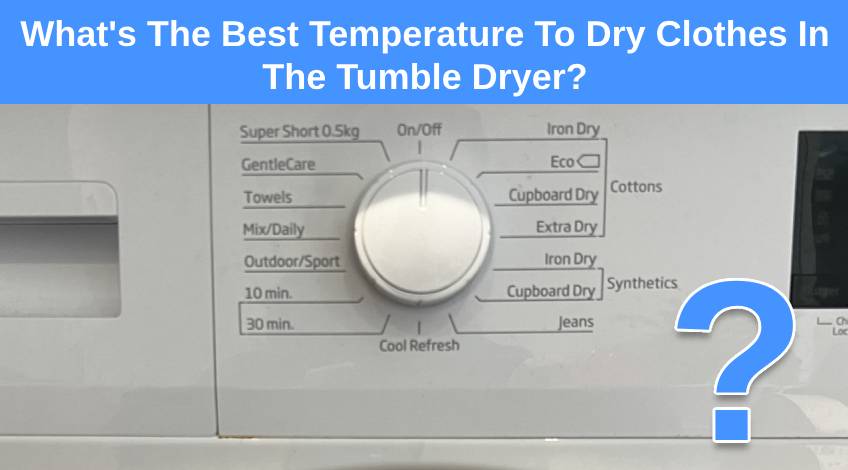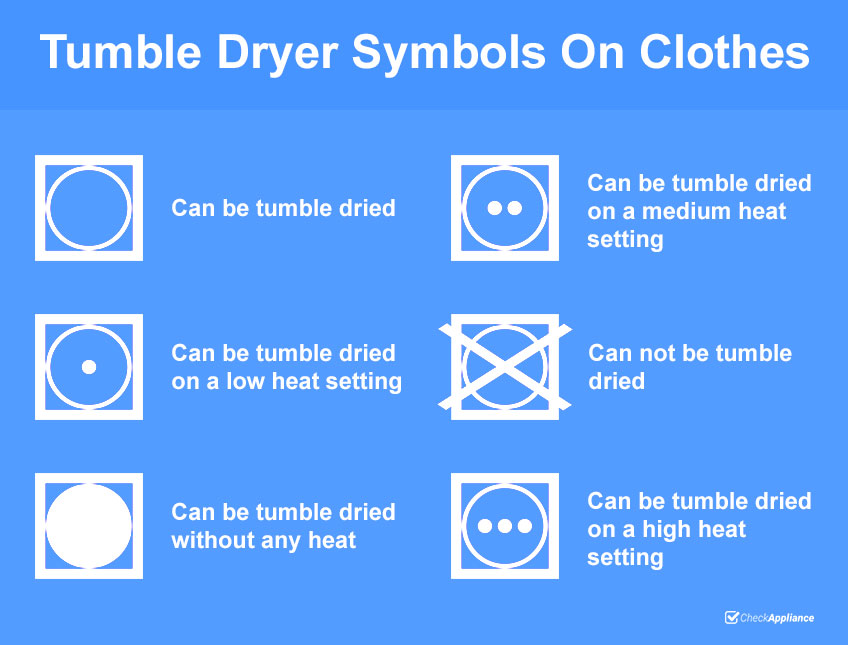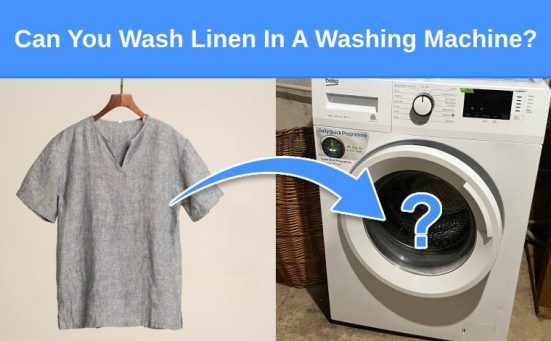
What’s The Best Temperature To Dry Clothes In The Tumble Dryer?
Drying clothes in a tumble dryer can be a real lifesaver, especially when you’re in a hurry or dealing with unpredictable weather. But have you ever wondered what’s the best temperature to dry your clothes in the tumble dryer?
After all, the highest setting can quickly remove moisture, but it can also damage your beloved garments. Each piece of clothing you have requires different care, especially in the laundry room.
In this article, we’re going to look into the factors that influence the ideal drying temperature for your clothes, making your laundry routine so much easier!
Start By Checking The Care Label Of Your Clothes
While it might be tempting to toss everything into the dryer and hope for the best, using the wrong temperature can lead to disastrous consequences. That’s where the care label comes to the rescue.
Care labels, those little tags sewn on the inner seams or hems of your clothing, contain crucial information on how to wash, dry, iron, and store your clothes to keep them in great shape. So, before you rush to set the dryer’s temperature, take a quick peek at the care label. It’s your garment’s way of telling you how it wants to be treated.
What Are The Tumble Drying Symbols In Clothes?
Care labels don’t have much space for detailed instructions, so they often use symbols to convey important information.
These symbols are like a secret code for your clothes. They use a combination of shapes like circles, squares, and dots, each with its own unique meaning. So, when it comes to drying, pay attention to these symbols to ensure you’re not subjecting your clothes to a hot disaster.
Here are some examples of the symbols you’ll find on your garments:

Understanding these symbols will give you a quick and visual guide on the right temperature and other essential factors for your clothes.
The Different Tumble Drying Cycles
Most tumble dryers have pre-programmed drying cycles designed to handle various types of clothing.

These cycles take the guesswork out of drying by setting the temperature, drying time, and tumbling action based on your clothing type. Let’s take a closer look at some of these cycles:
Cotton
The cotton programme is best suited for everyday wear like t-shirts, trousers, and towels. It uses high heat to quickly dry these sturdy garments.
Delicate or Gentle
Delicate or Gentle cycles are ideal for items with fragile fabrics. These cycles use low heat temperatures, making them perfect for drying delicate materials like silks, lace, and cashmere without causing any harm.
Synthetic
The Synthetic cycle is your go-to for everyday wear items, striking a balance between speed and safety. It uses medium heat to dry your clothes quickly without risking fading or damage.
Wool
Woollen, knitted, or crocheted items, like scarves, find their happy place in the Wool cycle. It dries these fabrics at a gentle, low temperature.
Mixed Load
The Mixed Load cycle is the jack-of-all-trades. It automatically adjusts heat and drying time to accommodate various clothing types in a single load.
Eco
If you want to be eco-friendly and save some money while doing your laundry, the Eco programme is your choice. This cycle consumes less energy, which is both kind to the environment and your wallet.
Quick Dry
For those days when you’re in a hurry, the Quick Dry cycle is there to rescue you. However, be cautious; it uses high heat and shorter durations, which might be a bit much for some garments.
The Different Tumble Dry Settings
While pre-programmed cycles are convenient, many dryers also offer manual control options.
Tumble dry settings give you more control over the drying process. You can manually adjust the temperature (low, medium, high) and drying time, changing them to your needs. But be mindful, as this also means it’s easier to make mistakes!
NOTE: Different manufacturers might use different names for these settings, so it’s a good idea to consult your machine’s manual.
No Heat
The “No Heat Tumble Dry” setting, also known as “Air Only” or “Air Fluff” on some dryers, removes moisture without using heat. It’s perfect for freshening up items, removing dust, or keeping delicate fabrics from damage.
Low Heat
The Low Heat setting maintains a temperature of 30°C and below, making it suitable for items like activewear, lingerie, and more delicate fabrics.
Medium Heat
Medium Heat, with temperatures ranging from 40°C to 50°C, is best for drying thicker or more durable fabrics, such as denim or heavier towels.
High Heat
High Heat, with temperatures exceeding 60°C, is ideal for robust fabrics like cotton or linens. It will speedily zap away moisture but is unsuitable for delicate or synthetic materials.
NOTE: What Does “Dry Flat” Mean? When the care label on your clothing says “Dry Flat,” it means you shouldn’t be tumble drying it. Instead, lay the garment out flat until all the excess moisture is gone.
The Material and Purpose Of Your Clothes
As mentioned earlier, the material of your garments plays a significant role in determining the best drying temperature. Different fabrics require different levels of care, especially when it comes to tumble drying.
The best temperature to dry clothes in the tumble dryer depends on the material of your garments.
Here’s a quick guide to temperature settings for various fabric types:
| Type of Clothes | Tumble Dry Setting |
|---|---|
| Cotton T-shirts | High Heat |
| Jeans | Medium Heat |
| Delicate Lingerie | Low Heat |
| Wool Sweaters | Low Heat (or Dry Flat) |
| Synthetic Sportswear | Medium Heat |
| Bath Towels | High Heat |
| Silky Blouses | Low Heat |
| Down-filled Jackets | Low Heat (or Dry Flat) |
| Baby Clothes | Low Heat |
| Knitted Garments | Low Heat |
| Stretchy Items | Low Heat (or Medium Heat) |
| Dresses | Low Heat (or Medium Heat) |
| Embellished Clothes | Low Heat |
Dry Your Clothes Without Worry!
By understanding your clothing, its care labels, and the settings on your tumble dryer, you can ensure your garments come out dry and in excellent condition every time.
So, before you press the start button, take a moment to check the care label and select the appropriate cycle or setting. Your clothes will thank you for it!
Do you have laundry tips to share? Feel free to leave a comment below!
SEE ALSO: Can A Tumble Dryer Iron Clothes? (get wrinkle free clothes out the dryer!)
Frequently Asked Questions
The length of a tumble dry cycle can vary depending on the dryer and the specific setting you choose. Typical cycles can range from 30 minutes to over an hour.
The “Eco” dryer setting is usually the most energy-efficient option, helping you save both energy and money.
Yes, dryers can use a significant amount of electricity, especially if you use high-heat settings. Using lower heat settings or an “Eco” setting can help reduce energy consumption.
To avoid shrinking, use the “Low Heat” or “Delicate” setting, especially for fabrics prone to shrinkage.
The tumble dry symbol is a small icon found on clothing care labels. It looks like a square with a circle inside, and it may have dots or lines inside the circle. It indicates whether and how you should tumble dry the garment, with the number of dots or lines specifying the heat level.




